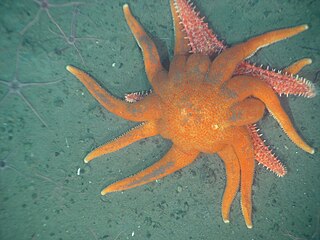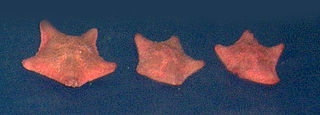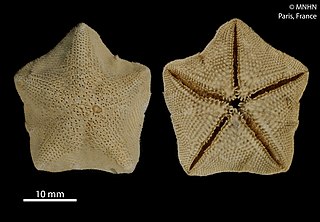
The Valvatida are an order of starfish in the class Asteroidea, which contains 695 species in 172 genera in 17 families.

The Asterinidae are a large family of sea stars in the order Valvatida.

Patiriella, commonly known as carpet sea star, is a genus of sea stars of the family Asterinidae.

Patiriella regularis, or New Zealand common cushion star, is a sea star of the family Asterinidae, native to New Zealand. It has an arm spread of up to 60 mm (2.4 in).

Parvulastra exigua, or the dwarf cushion star is a species of sea star in the family Asterinidae. It can be found in temperate intertidal marine communities from geographically widespread sites around the southern hemisphere.

Meridiastra mortenseni is a sea star of the family Asterinidae endemic to New Zealand. Discovered as a new species in 2002, it is named after T. Mortensen, who recorded it as distinct from Patiriella regularis, the New Zealand common cushion star, in 1925. Genetic evidence moved P. mortenseni from the Patiriella genus to Meridiastra in 2004.

Asterina is a genus of asteroideans in the family Asterinidae.

Callopatiria is a genus of starfish of the family Asterinidae.
Parvulastra parvivipara is a very small species of starfish in the family Asterinidae. It is a viviparous species and gives birth to live young. It lives in rock pools on intertidal granite rocks in a limited area of South Australia.

Cryptasterina pentagona is a species of starfish in the family Asterinidae. It is found in shallow waters in north eastern Australia. Its life cycle includes the release of large-yolked eggs and the development of planktonic larvae which is in contrast to the very similar Cryptasterina hystera which is viviparous. The two appear to have diverged from a common ancestral line only a few thousand years ago.

Cryptasterina hystera is a species of starfish. It is found in a limited region of the coast of Australia and is very similar in appearance to Cryptasterina pentagona. The two appear to have diverged from a common ancestral line a few thousand years ago.

Nepanthia is a genus of starfish of the family Asterinidae. Members of the genus have four to seven rays and are found in the eastern Pacific Ocean, ranging from Burma and Indonesia to Australia.
Paranepanthia is a genus of starfish of the family Asterinidae. Members of the genus have five rays and are found in the waters around Australia, Indonesia and Antarctic New Zealand.

Aquilonastra conandae is a species of starfish from the family Asterinidae found near the Mascarene Islands in the Indian Ocean. It is known for its asexual reproduction and is fissiparous. It is a small starfish, discrete and camouflaged, and occurs in coral reefs in the surf zone of large waves. The species was described in 2006 by Australian marine biologists P. Mark O'Loughlin and Francis Winston Edric Rowe, and gets its name from Chantal Conand.

Aquilonastra chantalae is a species of starfish from the family Asterinidae. Asterinid sea stars are typically quite small with an often pentagonal-shaped body, though there are exceptions. They are dorsally flattened and have short arms. The body's thin periphery is built up by very small marginal plates. One distinct characteristic of those in this family is the presence of an aboral face shaped by crescent-like plates.

Aquilonastra is a genus of small sea stars within the family Asterinidae. It has over 20 described species.
Parvulastra vivipara, the Tasmanian live-bearing seastar, is a tiny, uniformly orange-yellow seastar, up to 15 mm (0.6 in) across. The species usually has five short arms and is a rounded, pentagon shape. Morphological variation is common and three, four or six arms are occasionally present. It is endemic to coastal waters in southeast Tasmania.

Aquilonastra burtoni is a species of small sea star from the family Asterinidae from the Red Sea which has colonised the eastern Mediterranean by Lessepsian migration through the Suez Canal, although the Mediterranean populations are clonal reproducing through fissiparous asexual reproduction. It was originally described in 1840 by the English zoologist and philatelist John Edward Gray.

Parvulastra dyscrita is a species of starfish belonging to the family Asterinidae. The species is found in Southern Africa.

Cryptasterina is a genus of starfish belonging to the family Asterinidae. They occur in the Indian and Western Pacific Oceans.















